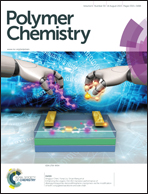Amidoxime functionalization of mesoporous silica and its high removal of U(vi)†
Abstract
Amidoxime-functionalized mesoporous silica has been prepared by the self-assembly co-condensation of tetraethoxysilane (TEOS) and 2-cyanoethyltriethoxysilane (CTES). By varying the molar ratio of CTES, a series of sorbents with different densities of organic groups have been obtained and applied to eliminate U(VI) ions from aqueous solutions. Sorption isotherms and kinetics have been investigated to discuss the influence of organic group densities on the sorption performance. Organic functionalization has a dual influence on both sorption capacities and sorption rates. The sorption capacity increases with the initial increase of organic group density until it reaches the maximum and then decreases with further increase of organic functionalization. The optimal dosage corresponds to the balance between the structural porosities of the sorbent and the loading contents of organic functional groups. Sorption mechanisms have been examined using the X-ray photoelectron spectra and Fourier transformed infrared spectra of sorbents before and after uranium sorption, and the results indicate that the sorption is mainly attributed to the formation of surface complexes between U(VI) and the amidoxime groups.


 Please wait while we load your content...
Please wait while we load your content...